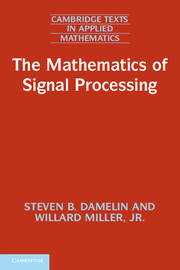Book contents
- Frontmatter
- Contents
- Preface
- Introduction
- 1 Normed vector spaces
- 2 Analytic tools
- 3 Fourier series
- 4 The Fourier transform
- 5 Compressive sampling
- 6 Discrete transforms
- 7 Linear filters
- 8 Windowed Fourier and continuous wavelet transforms. Frames
- 9 Multiresolution analysis
- 10 Discrete wavelet theory
- 11 Biorthogonal filters and wavelets
- 12 Parsimonious representation of data
- References
- Index
1 - Normed vector spaces
Published online by Cambridge University Press: 05 June 2012
- Frontmatter
- Contents
- Preface
- Introduction
- 1 Normed vector spaces
- 2 Analytic tools
- 3 Fourier series
- 4 The Fourier transform
- 5 Compressive sampling
- 6 Discrete transforms
- 7 Linear filters
- 8 Windowed Fourier and continuous wavelet transforms. Frames
- 9 Multiresolution analysis
- 10 Discrete wavelet theory
- 11 Biorthogonal filters and wavelets
- 12 Parsimonious representation of data
- References
- Index
Summary
The purpose of this chapter is to introduce key structural concepts that are needed for theoretical transform analysis and are part of the common language of modern signal processing and computer vision. One of the great insights of this approach is the recognition that natural abstractions which occur in analysis, algebra and geometry help to unify the study of the principal objects which occur in modern signal processing. Everything in this book takes place in a vector space, a linear space of objects closed under associative, distributive and commutative laws. The vector spaces we study include vectors in Euclidean and complex space and spaces of functions such as polynomials, integrable functions, approximation spaces such as wavelets and images, spaces of bounded linear operators and compression operators (infinite dimensional). We also need geometrical concepts such as distance and shortest (perpendicular) distance, and sparsity. This chapter first introduces important concepts of vector space and subspace which allow for general ideas of linear independence, span and basis to be defined. Span tells us for example, that a linear space may be generated from a smaller collection of its members by linear combinations. Thereafter, we discuss Riemann integrals and introduce the notion of a normed linear space and metric space. Metric spaces are spaces, nonlinear in general, where a notion of distance and hence limit makes sense. Normed spaces are generalizations of “absolute value” spaces.
Information
- Type
- Chapter
- Information
- The Mathematics of Signal Processing , pp. 3 - 72Publisher: Cambridge University PressPrint publication year: 2011
